HOPE not hate uses cookies to collect information and give you a more personalised experience on our site. You can find more information in our privacy policy. To agree to this, please click accept.
On 22 August 2020, as many as 200 street rallies were held across the US, Canada and other countries, as well as in eleven cities…
On 22 August 2020, as many as 200 street rallies were held across the US, Canada and other countries, as well as in eleven cities and towns in the UK, under the inoffensive slogan “Save Our Children”. The deliberately vague branding belied the true motive of the events: to raise awareness that President Trump is waging a secret war against a cabal of powerful Satanic paedophiles, alleged to be kidnapping, torturing and even cannibalising children on a vast scale.
This is the worldview of QAnon, a groundless conspiracy theory that has spread rapidly in the US and developed pockets of support across the globe. From its inauspicious origins on the 4chan message board in October 2017, QAnon has spawned thousands of Facebook groups and Instagram pages, numerous documentaries, a subculture of researchers and promoters, a cottage industry of merchandise, and various campaigns, coordinated actions and street movements. Despite the FBI warning about its capacity to motivate domestic terrorism, and a number of attacks having been linked to the theory, President Trump has failed to condemn the movement and some of its believers appear poised to enter Congress in November.
A growing number of British people are being drawn to the theory as it develops beyond its roots in the intensely hyperpartisan and US-centric right, moving from a niche far-right interest that we have termed orthodox QAnon into a broader, less uniform form we call eclectic QAnon. This development has enabled the theory to gain supporters from across the political spectrum and of diverse backgrounds.
QAnon as it stands today is a decentralised, grand and multifaceted phenomenon, at once a conspiracy theory, a political movement and a quasi-religion, with variants tailored to chime with different subcultures and national contexts. Its central narrative blends legitimate concerns about child trafficking and child abuse with fantastical misinformation and antisemitic tropes, fostering a dangerous anger in the process.
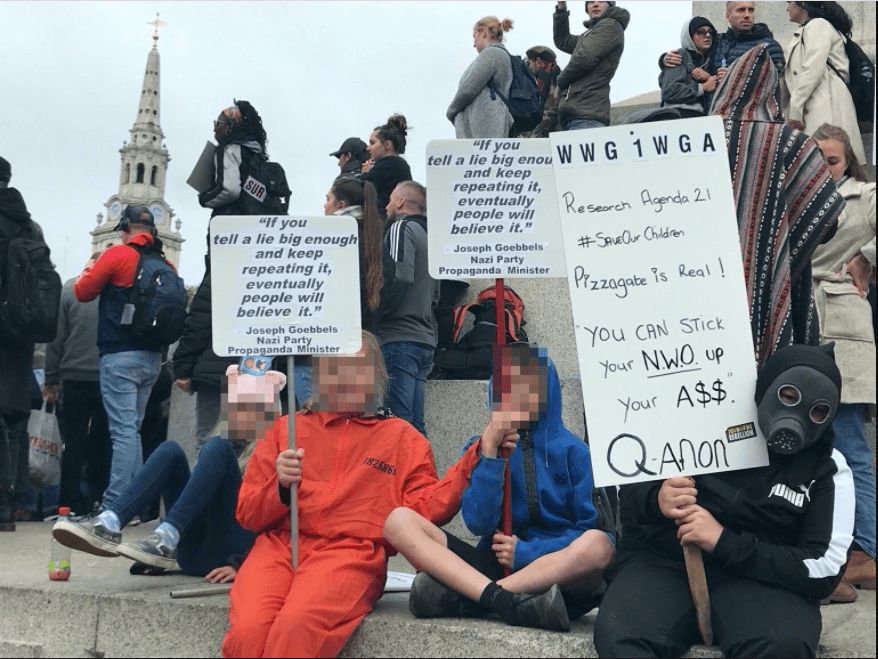
QAnon began on 28 October 2017, when a user of the message board 4Chan, later identified as “Q”, claimed to have insider knowledge that Hillary Clinton would be arrested the following day. This kind of false lead would become an unintentional trademark for Q, who claimed in further posts to be a Trump insider with high level security clearance (at time of writing, Q’s identity remains unknown). Nonetheless, Q has made more than 4,800 subsequent posts (known as “Q drops”), cryptic messages outlining a predatory, Satanic conspiracy dictating world events. As users of 4chan refer to each other as “anons”, the name “QAnon” was born.

Q, who has moved from 4Chan to its successor sites 8Chan and then 8Kun, has gained an army of enthusiastic devotees who place faith in the supposed “Plan” to take down the cabal, as well as a cottage industry of influencers who decode Q’s messages. Q tells his followers that they represent a “digital army” whose role is to preach the truth of the movement in order to lay the groundwork for the eventual “Great Awakening”, details of which are so shocking that the population at large cannot be informed of them without the elaborate pantomime of gradual revelation. The grand QAnon narrative is inflected with shades of millenarianism; the battle between Good and Evil will end when the messianic President overthrows the Satanists, ushering in a new period of global prosperity. The role of orthodox QAnon influencers is to guide less well-informed adherents in much the same way as scholars interpret sacred texts for religious movements.
QAnon is a “superconspiracy”, capable of merging numerous pre-existing sub-conspiracies, with new theories flourishing and older tropes finding a new lease of life under its rubric. QAnon draws particularly from the “New World Order” (NWO) tradition, which for decades has alleged that a secret elite is controlling events across the globe for the purpose of world domination. A more recent precursor is the “Pizzagate” theory that emerged ahead of the 2016 Presidential election, which alleged that Democratic politicians were trafficking children for use in paedophilic rituals. The frantic, independent theorising of Q followers has proved capable of rolling any event into its grand narrative, from the momentous, such as the JFK assassination or the sinking of the Titanic, to the seemingly insignificant, such as the mispricing of items on the retail site Wayfair, or a “hidden symbol” in a frame of a Disney film. This gives QAnon a certain fluidity; in some cases, adherents of the broader ideology might choose to emphasise certain aspects and minimise others as part of a calculated effort to maximise its appeal to the uninitiated, but followers also naturally focus on the aspects of the narrative that resonate most strongly with them, and thus present the movement in differing ways. The overall effect is kaleidoscopic and disturbing, but for followers the core narrative provides a framework of Good versus Evil through which the world can be understood.
A strong sinew of antisemitism has run through QAnon since the beginning. Q has identified a triumvirate of “puppet masters” at the centre of the international cabal: the Rothschild family, George Soros and the House of Saud. Soros and the Rothschild family have long been common targets for antisemitism, with the latter smeared as sinister, sometimes supernatural global financiers for 200 years. Q has directly tapped into this toxic legacy, for example erroneously alleging that Rothschild has a controlling interest in every nation’s central bank. Q has also suggested that Hitler was a “puppet”, a notion popular among Holocaust deniers, and alluded to Israel’s role in the conspiracy, for example stating: “We are saving Israel for last. Very specific reason not mentioned a single time”.
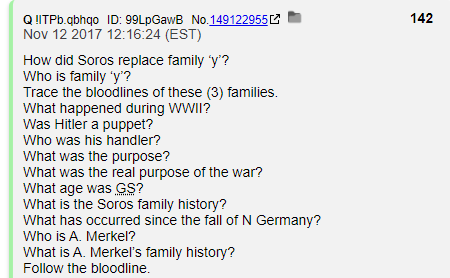
Such statements have encouraged some followers to import established antisemitic theories into the QAnon narrative. Like the NWO theories that preceded it, QAnon builds on old prejudices alleging the existence of a secret Jewish government, sometimes in league with Satanic forces, exercising a “hidden hand” behind world events. QAnon-aligned Facebook groups were riddled with theories of Jewish control, including references to The Protocols of the Elders of Zion, a notorious antisemitic forgery outlining a fiendish plan for world control, including infiltrating the media and political parties to brainwash and enslave populations, themes prevalent among QAnon followers. A popular subsidiary theme alleges that “adrenochrome” is at the heart of the conspiracy, a mythical drug allegedly harvested by the cabal from the blood of children, echoing the ancient antisemitic blood libel myth.
QAnon as it developed from 2017-2019 – what we term orthodox QAnon – has limited global appeal, being a hyperpartisan pro-Trump narrative with a heavy focus on American political figures who have little relevance or familiarity outside of the US. However, a key turning point in its development has been the COVID-19 pandemic and subsequent government measures around the world, allowing the once-niche theory to broaden and spread at a rapid pace since March 2020.
The exponential growth of QAnon has dovetailed with a boom of COVID-19 conspiracy theories, which include claims that 5G radiation is the cause of the health crisis and/or that a potential vaccine will contain a microchip to track populations. This is at least in part due to the efforts of Q, who has repeatedly suggested that measures to control the pandemic are part of a plot to subvert the US election. QAnon followers have variously speculated that the virus is either entirely fabricated or a deep state bioweapon to allow for election rigging, scuppering Trump’s “Plan”, and allowing the cabal to tighten their totalitarian grip; prominent figures in the fight against COVID-19, such as Bill Gates and Antonio Fauci, have been widely condemned as members of the cabal. The exploitation of fears around the contagion has greatly aided the spread of the theory; a July report by the Institute of Strategic Dialogue (ISD) found that membership of QAnon Facebook groups increased by 120% in March 2020, and that between 23-25 March, posts on Twitter containing both keywords relating to COVID-19 and keywords relating to QAnon increased by 422%.
The pandemic coincided with the decentralisation of QAnon into a broader, less uniform form we term eclectic QAnon. Eclectic QAnon is largely decoupled from Q drops and orthodox QAnon influencers, downplays many references to American political figures, does away with much of the dense jargon of orthodox QAnon and focuses on broader conspiratorial notions such as those about elite child trafficking cults, thereby translating to other national contexts more successfully. These broader forms of the theory have been greatly aided by the adoption of inoffensive slogans such as “Save the Children/Save our Children” from July 2020, an adjustment which also helped QAnon groups survive the social media crackdowns that month. The enormously emotive idea that thousands of children are being kept captive in dungeons and tunnel networks across the world has drawn in many who might otherwise have rejected the heavily pro-Trump and narrow political narratives of orthodox QAnon. QAnon researcher Marc-André Argentino reported in September that membership of 114 Facebook groups which present a softer anti-trafficking face, but were actually dominated by QAnon content, increased by 3,029% since July.
Over the summer of 2020, both Twitter and Facebook finally began to crack down on the QAnon groups, pages and accounts that had proliferated on their platforms for almost three years, and on October 6, Facebook announced it would attempt to remove QAnon’s presence from both Facebook and Instagram entirely. This was followed by what appears to be swift and decisive action. However, whilst this will undoubtedly impact the ability of the theory to spread to new people, it cannot reverse the damage that three years of largely unchecked proliferation on social media platforms has done.
QAnon established small pockets of support in the UK from the outset, including a key global orthodox QAnon figure in Martin Geddes, a computer scientist from Staines with a 210,000 Twitter following, and who has crossed the Atlantic to network with American QAnon figures. The earliest explicitly QAnon Facebook group we have identified in the UK dated back to June 2018, roughly eight months after the first Q drop. However, QAnon remained an exceedingly niche interest in the UK for the first two and a half years of its existence; prior to March, we had identified just three UK-specific Facebook groups devoted to QAnon, with a combined membership of less than 5,000.
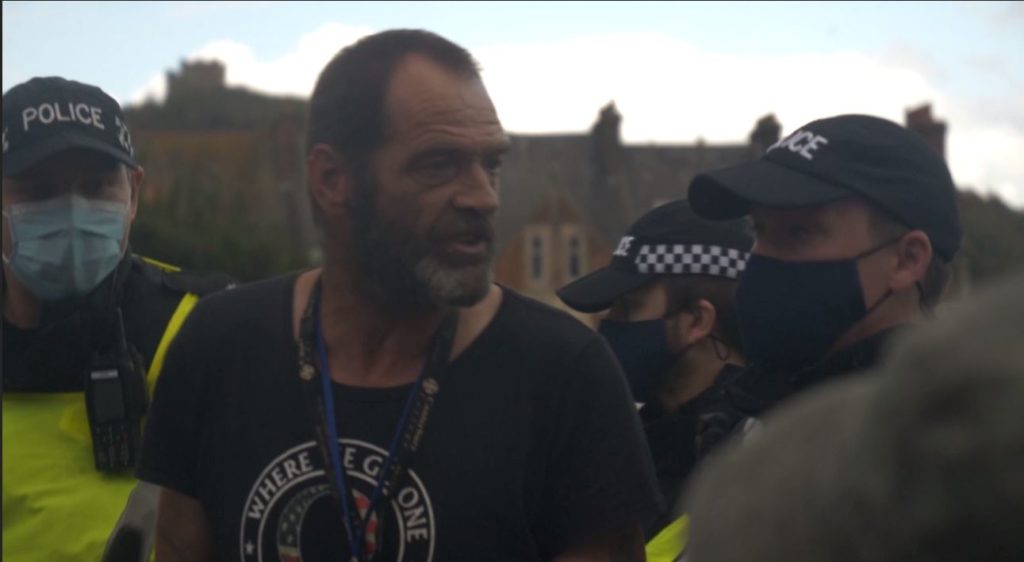
This was to change with the onset of the pandemic. New QAnon groups began to spring up regularly, and Facebook data cited by Wired shows an 800% increase in the membership of the top 20 UK QAnon-oriented open groups that were “regularly posting about QAnon or QAnon-adjacent themes” in the period between 1 March and 18 September 2020, to roughly 160,000 members. Private UK Facebook groups presenting an ambivalent relationship to QAnon, but still heavily featuring QAnon content, have grown at a remarkably rapid rate; for example, Eyes Wide Open (EWO), founded in June, currently boasts 49,000 members, and Freedom for the Children UK (FFTCUK) has gained 13,000 since launching in July. Both groups have evaded the bans as of early October.
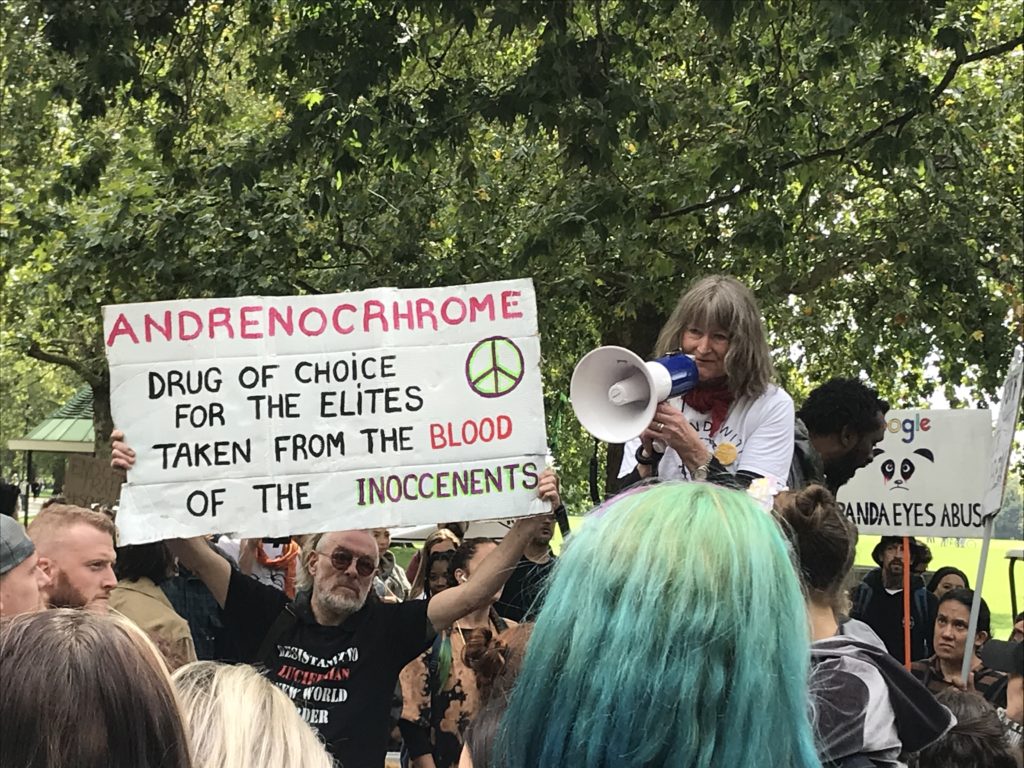
British conspiracy theorists have refocused the theory to incorporate UK issues, such as the Operation Yewtree and Operation Conifer investigations into historical child sexual abuse, Prince Andrew’s implication in the Jeffrey Epstein scandal, and the disappearance of Madeline McCann. The influence of British conspiracy theorists such as David Icke, who has promoted the idea of a global, elite Satanic paedophile cult cannibalising children long before QAnon, is also discernible. QAnon camouflages such fantastical claims amongst the legitimate, with news items about the conviction of paedophiles, grooming gangs, and allegations that children are imprisoned underneath Buckingham Palace, flowing together into a soup of outrage and often violent language.
The energy building on social media has also manifested on the streets of the UK. In July 2020, the first “Save the Children” rally was held in Hollywood, California with successor events quickly arranged in as many as 200 cities in the US, the UK and other countries. FFTCUK, the outfit behind the British demonstrations, has held events in 17 cities and towns in the UK so far, and whilst many of these were tiny, some attracted hundreds of attendees, QAnon believers mingling with people concerned by legitimate child welfare issues. EWO co-organised a 5 September protest that brought together as many as 1,000 people to march from Hyde Park to Broadcasting House, hurling abuse at the Oxford Street Disney store on route. Anti-lockdown, anti-5G and anti-vaccine demonstrations in the UK – including two Trafalgar Square events upwards of 10,000 strong – have seen a noticeable QAnon presence. Notably, the most energetic conspiracy theory-driven anti-lockdown protest group in the UK, Stand Up X, is increasingly adopting eclectic QAnon notions as campaigning issues.
QAnon is uniting long-standing conspiracy theorists and new converts into a loose movement that is making false promises and calls for action. The US election will have considerable knock-on effects, but there is little reason to think QAnon will disappear, whatever the result. As we enter a long winter of further lockdowns and isolation, and the economic impacts of the crisis start to bite, we could see more turning to disinformation and conspiracy theories in order to make sense of a chaotic world.
News coverage of QAnon in the UK has, at times, verged on alarmist, and it is important not to inflate the threat it poses; as our polling shows, it is at present relatively niche. However, as we outline, there is scope for the further spread of the theory, which is cause for concern for the below reasons.
Firstly, antisemitic tropes are inherent to the theory. Whilst some followers may be conscious antisemites, others may be ignorantly regurgitating tropes they are unaware are racist, and still others are simply turning a blind eye, denying charges of antisemitism as an “MSM” (mainstream media) smear. Regardless, the spread of the theory is promulgating an ancient form of prejudice, and has the potential to radicalise converts towards Jew hatred.
Secondly, there is scope for the far-right exploitation of the developing eclectic QAnon scene in the UK, which lacks ideological and organisational structure. Support for QAnon comes from all political stripes, but the theory has developed pockets of support among the British radical and far right. Whilst this has so far largely been limited to an individual rather than organisational basis, the QAnon worldview overlaps significantly with pre-existing far-right narratives, opening up opportunities for further cross-pollination.
Thirdly, QAnon has the potential to sow a dangerous distrust in institutions. All conspiracy theories exploit and compound distrust to some degree, which is not always wholly bad; a leading scholar in the field, Joseph Uscinski, has argued that conspiracy theories, as a form of political dissent, are “necessary to the healthy functioning of society because they help balance against concentrations of power”. However, QAnon emerged as a partisan smear, and the idea that various politicians and other public figures are infernal, child-eating enemies of the people is stoking a particularly toxic cynicism. Additionally, the incorporation of COVID-19 conspiracy theories into the QAnon narrative has the potential to erode trust in medical experts and authorities, and further the spread of health misinformation and pseudoscience in the midst of a global pandemic.
Fourth, QAnon risks obscuring genuine child abuse and hampering legitimate efforts to better child welfare. Child trafficking and other forms of exploitation are pressing issues, and have, as the prolific crimes of Jeffrey Epstein, Jimmy Savile and others have shown, been carried out by well-connected people. However, the sole focus on elites distorts reality; as Lori Cohen of the anti-child trafficking organisation ECPAT-USA told The New York Times, “This is not happening in some secret cabal. It’s happening in every single community”. #SaveTheChildren began as a fund-raising campaign for the longstanding children’s charity Save The Children, but was hijacked by QAnon believers in July, leading Facebook to temporarily disable the hashtag after it became awash with misinformation. American human trafficking hotlines have reported being overwhelmed by false reports relating to QAnon. At demonstrations in the UK, QAnon acolytes have shared stages with highly impassioned campaigners against genuine child exploitation, some of whom claim to have been victims of such abuse themselves. The meshing of crucial issues with grotesque misinformation risks burying genuine cases among false, and diverting energy and resources from groups that could make genuine progress.
Lastly, the highly emotive narratives at the core of QAnon have the potential to inspire disruption, harassment and even violence. The QAnon worldview is steeped in violent rhetoric, built on the idea that the promised global Great Awakening will be preceded by “The Storm”, the mass trials and execution of liberal politicians, celebrities and other figures aligned with the cabal. Q has presented this impending day of judgement as imminent and assured, which in the orthodox vision is to be carried out by mythical “white hats” rather than by QAnon followers themselves. However, the theory has spiralled out of both Q’s control and that of the traditional coterie of influencers.
In 2019, an FBI memo listed QAnon and the related Pizzagate conspiracy theories as a potential terror threat, saying thatthey are “very likely” to “occasionally driv[e] both groups and individual extremists to carry out criminal or violent acts”. Numerous attempted and successful acts of violence have since been committed in the US by individuals who have endorsed QAnon. These have been uncoordinated actions by lone actors with minimal planning, and QAnon advocates rightly point out that such incidents cannot be taken as representative of a movement hundreds of thousands strong.
There are, however, reasons to be concerned that QAnon has the potential for greater disruption. Fantasising about the bloodshed to come is a striking feature of the online spaces where QAnon adherents gather, including in the UK. It is impossible to know how seriously many followers take their beliefs, and whether they would act on them, but the risk remains that individuals may be motivated towards criminality.
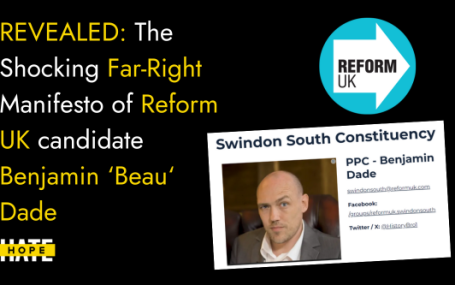
A Reform Party candidate fantasised about deporting “millions” of British citizens to “rid itself of the foreign plague we have been diseased with”. UPDATE: Reform…